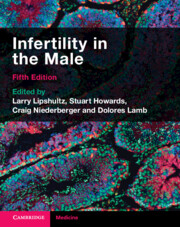Book contents
- Infertility in the Male
- Infertility in the Male
- Copyright page
- Contents
- Contributors
- Foreword
- Abbreviations
- Introduction
- Section 1 Scientific Foundations of Male Infertility
- Section 2 Clinical Evaluation of the Infertile Male
- Section 3 Laboratory Diagnosis of Male Infertility
- Chapter 17 Laboratory Evaluation of the Infertile Male
- Chapter 18 Advanced Diagnostic Approaches to Male Infertility
- Chapter 19 Evaluating Defects in Sperm Function
- Chapter 20 Cryopreservation of Sperm – History and Current Practice
- Section 4 Treatment of Male Infertility
- Section 5 Health Care Systems and Culture
- Index
- References
Chapter 19 - Evaluating Defects in Sperm Function
from Section 3 - Laboratory Diagnosis of Male Infertility
Published online by Cambridge University Press: 08 July 2023
- Infertility in the Male
- Infertility in the Male
- Copyright page
- Contents
- Contributors
- Foreword
- Abbreviations
- Introduction
- Section 1 Scientific Foundations of Male Infertility
- Section 2 Clinical Evaluation of the Infertile Male
- Section 3 Laboratory Diagnosis of Male Infertility
- Chapter 17 Laboratory Evaluation of the Infertile Male
- Chapter 18 Advanced Diagnostic Approaches to Male Infertility
- Chapter 19 Evaluating Defects in Sperm Function
- Chapter 20 Cryopreservation of Sperm – History and Current Practice
- Section 4 Treatment of Male Infertility
- Section 5 Health Care Systems and Culture
- Index
- References
Summary
Semen analysis has been the standard of clinical laboratory assessment(s) of male fertility potential for more than 70 years [1–4]. Methodologies for performing the semen analysis, along with standard practices to ensure quality in clinical laboratory practices throughout testing, have been codified in multiple World Health Organization publications [5–9]. A common, and albeit disappointing, conclusion regarding the semen analysis is that the lower reference limits have limited predictive value for fertility or, for that matter, infertility (see, for example, [10–14]). A partial explanation for this inadequacy is that, with the exception of sperm motility, sperm function requirements that are necessary for successful fertilization and term delivery are not assessed in the semen analysis. This dilemma impacts the ability of clinicians to provide an evident diagnosis to the patient couple concerning the presence/absence of male subfertility, especially in the absence of genetic, hormonal, or urogenital abnormalities. This dilemma becomes further exacerbated for the clinician who must decide on an appropriate therapeutic strategy to address the infertility and for the patients who balance their desires in conjunction with spiritual, emotional, and financial considerations.
- Type
- Chapter
- Information
- Infertility in the Male , pp. 363 - 380Publisher: Cambridge University PressPrint publication year: 2023



